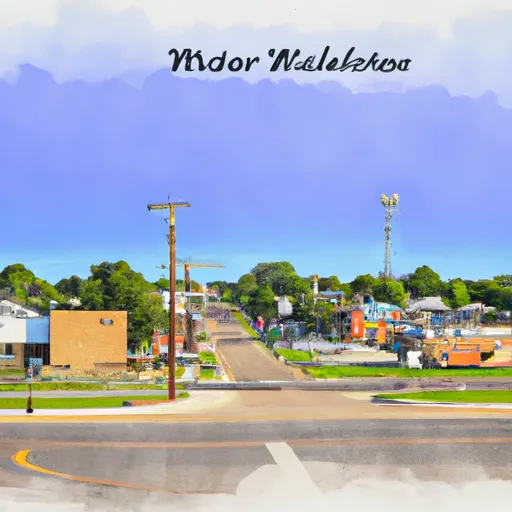-
 Snoflo Premium
Snoflo Premium
Get unlimited access to all our content
With no Ad interruptions! - Start Your Free Trial Login with existing account
Walton
Eden Index
Climate
8.1
•
Recreation
3.5
•
Community
•
Safeguard
4.4/10

Walton, Nebraska is a small village located in Lancaster County, in the eastern part of the state. The climate in Walton is characterized by hot summers and cold winters, with a significant amount of precipitation throughout the year. Summers are typically warm, with temperatures averaging in the mid-80s (Fahrenheit), while winters can be quite cold, with temperatures dropping to the mid-teens.
As for hydrology constituents, Walton is situated near Salt Creek, a major waterway in the area. The creek serves as a source of water for various recreational activities such as fishing, boating, and kayaking. It also provides a serene environment for nature enthusiasts to enjoy.
In terms of outdoor recreation opportunities, Walton offers several options. The nearby Branched Oak State Recreation Area is a popular destination for camping, hiking, and picnicking. It also features a large lake where visitors can enjoy swimming, boating, and fishing. The surrounding countryside provides ample opportunities for exploring nature and wildlife observation. Additionally, the nearby town of Lincoln offers various parks, trails, and golf courses for outdoor enthusiasts to enjoy.
Overall, Walton, Nebraska provides a pleasant climate, access to water resources, and numerous outdoor recreation opportunities for residents and visitors alike.
What is the Eden Index?
The Snoflo Eden Index serves as a comprehensive rating system for regions, evaluating their desirability through a holistic assessment of climate health, outdoor recreation opportunities, and natural disaster risk, acknowledging the profound impact of these factors on livability and well-being.
Climate Health Indicator (CHI): 8.1
Walton receives approximately
786mm of rain per year,
with humidity levels near 82%
and air temperatures averaging around
11°C.
Walton has a plant hardyness factor of
5, meaning
plants and agriculture in this region thrive during a short period during spring and early summer. Most
plants will die off during the colder winter months.
By considering the ideal temperature range, reliable water supplies, clean air, and stable seasonal rain or snowpacks, the Climate Health Indicator (CHI) underscores the significance of a healthy climate as the foundation for quality living.
A healthy climate is paramount for ensuring a high quality of life and livability in a region, fostering both physical well-being and environmental harmony. This can be characterized by ideal temperatures, reliable access to water supplies, clean air, and consistent seasonal rain or snowpacks.
Weather Forecast
Streamflow Conditions
Lower Platte
Area Rivers
Lower Platte
Snowpack Depths
Lower Platte
Reservoir Storage Capacity
Lower Platte
Groundwater Levels
Recreational Opportunity Index (ROI): 3.5
The Recreational Opportunity Index (ROI) recognizes the value of outdoor recreational options, such as parks, hiking trails, camping sites, and fishing spots, while acknowledging that climate plays a pivotal role in ensuring the comfort and consistency of these experiences.
Access to outdoor recreational opportunities, encompassing activities such as parks, hiking, camping, and fishing, is crucial for overall well-being, and the climate plays a pivotal role in enabling and enhancing these experiences, ensuring that individuals can engage in nature-based activities comfortably and consistently.
Camping Areas
| Campground | Campsites | Reservations | Toilets | Showers | Elevation |
|---|---|---|---|---|---|
| Oregon Trail RV Park | 16 | 1,182 ft | |||
| Marysville City Park | None | 1,144 ft | |||
| Big Indian NRD Rec Area | 50 | 1,334 ft | |||
| Tuttle Creek State Park | 700 | 1,027 ft | |||
| Tuttle Creek Cove - Tuttle Creek Lake | 55 | 1,183 ft | |||
| Feits Memorial Park | 15 | 1,228 ft | |||
| Blue Rapids/Riverside City Park | None | 1,121 ft | |||
| Waterville City | 6 | 1,161 ft | |||
| Rockford Lake State Rec Area | 107 | 1,390 ft | |||
| Stockdale - Tuttle Creek Reservoir | None | 1,157 ft |
Nearby Ski Areas
Catastrophe Safeguard Index (CSI):
The Catastrophe Safeguard Index (CSI) recognizes that natural disaster risk, encompassing floods, fires, hurricanes, and tornadoes, can drastically affect safety and the overall appeal of an area.
The level of natural disaster risk in a region significantly affects safety and the overall livability, with climate change amplifying these risks by potentially increasing the frequency and intensity of events like floods, fires, hurricanes, and tornadoes, thereby posing substantial challenges to community resilience and well-being.
Community Resilience Indicator (CRI):
The Community Resilience Indicator (CRI) recognizes that education, healthcare, and socioeconomics are crucial to the well-being of a region. The CRI acknowledges the profound impact of these elements on residents' overall quality of life. By evaluating educational resources, healthcare accessibility, and economic inclusivity, the index captures the essential aspects that contribute to a thriving community, fostering resident satisfaction, equity, and social cohesion.

